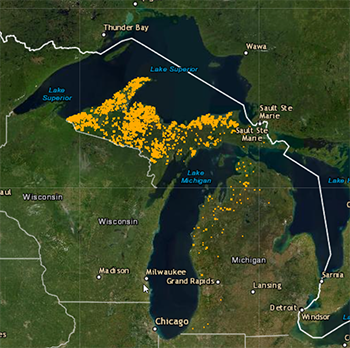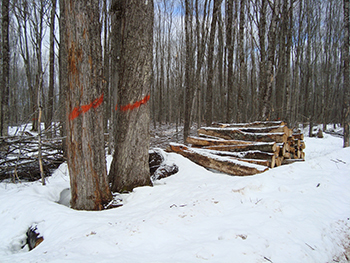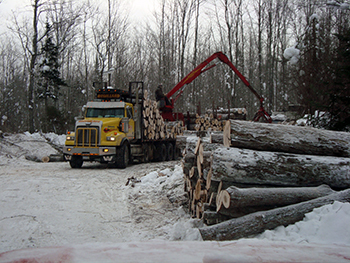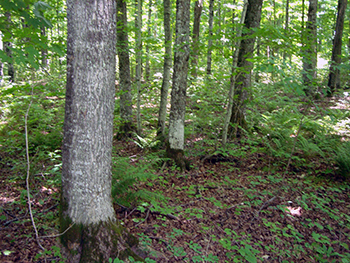Michigan’s Commercial Forest Program has numerous benefits
By KATHLEEN LAVEY
Michigan Department of Natural Resources
Charles E. Nebel loves to talk about forests – about planting jack pine on 40 acres of his family’s land holding a quarter-century ago, about red pines planted on former farmland near Chatham in Alger County.
“There were five 40-acre parcels there, and we planted that to red pine,” he said. “That was about nine or 10 years ago, and the trees are over our heads now. They’re 6 feet tall or more.”
Nebel’s family has owned forest lands in the Upper Peninsula since the 1920s, when his father began buying tax-reverted land.
Today, more than 3,200 acres of the family’s holdings are enrolled in the Michigan Department of Natural Resources’ Commercial Forest program. It offers a property tax break to private landowners who are required to offer foot access to the public for hunting, fishing and trapping and manage their land strictly for long-term timber production.

“Our lands are available for people to use during the hunting seasons, and we have no objections to that,” Nebel said. “We don’t put up fences, we don’t put up gates.”
The Nebel family’s properties in Alger, Schoolcraft, Delta and Marquette counties are among about 2.2 million acres in Michigan enrolled in the program.
Approximately 1,800 entities – families, corporations and individuals – are enrolled, with land taxed at a rate of $1.35 per acre in 2022.
“The Commercial Forest Program makes it possible to grow timber profitably,” said Gary Willis, a DNR service forester based in Baraga who works with landowners in the program. “It’s like any other agricultural endeavor. The forest products industry is a huge economic sector.”
Michigan’s forest products industry generates more than $21 billion a year and supports more than 91,000 jobs, from logging to lumber and paper mills to manufacturing wood products.
The Commercial Forest program started in Michigan in 1925, when forests were recovering from the pine lumbering boom of the late 19th century.
“By 1925, the lumbering era had left Michigan. To encourage landowners to begin reforesting, the Commercial Forest program was created, which provided a property tax incentive due to the cost of the property taxes,” said Karen Maidlow, Commercial Forest Program leader, who administers the program.
|

The program has been modified over the years to serve the needs of landowners and the people of Michigan.
A landowner must have 40 contiguous acres to apply for the program, although some owners have enrolled more than 200,000 acres. Applications are accepted from Jan. 1 through April 1 each year. After an application is submitted, a field review and a hearing are conducted.
A forester conducting a field review of the property looks for several things during the review. For example, since lands are open to foot traffic to the public for hunting, fishing, and trapping, “no trespassing” signs are forbidden.
Foresters look to see if there is recent activity, such as a new trail road or a timber harvest, whether the management taking place on the property matches the plan filed by the property owner and whether the land is reasonably accessible to the public.
No structures – even deer blinds – are allowed on Commercial Forest property. Nothing can be left behind on the lands without permission of the landowner, except traps placed by licensed trappers.
Landowners must have a forest management plan in place to allow for timber harvests and regeneration well into the future.
“CF landowners must contract with a professional forester to write their management plan,” Willis said. “Because there is much flexibility in silvicultural prescriptions for timber management, landowners can work closely with a professional forester to obtain a management plan tailored to their goals and objectives for ownership.
“Commercial Forest landowners must harvest timber in accordance with their management plan. The DNR reviews all management plans to assure adherence to program requirements.”
|

If approved, landowners sign a listing certificate, which the DNR records at the county Register of Deeds office. The DNR notifies township assessors to move the land from the ad valorem (based on the property value) tax roll to the Commercial Forest-specific tax roll.
“In many counties, especially in the Lower Peninsula, that amounts to a huge tax break,” Maidlow said.
DNR research shows that Michigan residents are nearly unanimous in their love of forests, with 98% of people surveyed saying forests keep Michigan beautiful, 97% agreeing that forests provide important homes for wildlife and a vast majority agreeing that forests are important for clean air and water. A total of 87% of survey respondents agreed that healthy forests are important to provide wood products society needs.
The Commercial Forest program touches on all those interests and helps ensure that Michigan’s forests remain.
“Land that is enrolled in the CF Program is enrolled in perpetuity until which time a parcel is withdrawn," Nebel said. “The program is designed to encourage forest legacy – the passing down of well-managed forest resources to future generations.
“There are many factors in play today that discourage forest legacy. However, what we have repeatedly observed is that families that work and love the land and its resources together tend to stay together. The Commercial Forest tax rate makes that legacy affordable.”
Nebel said he wouldn’t hesitate to recommend the program to other landowners.
|

“We’ve been able to maintain the property, use it for timber, and not lose our shirts keeping the taxes paid,” he said. “If we had not used this to give us the ability to own the property, we would probably not own any of it. We really wanted to find a way to use it and preserve it.”
Program at a glance
There are 2.2 million acres enrolled in the Commercial Forest program in Michigan.
Owners receive a property tax reduction in exchange for required forest management and public access for hunting, fishing and trapping.
Fishing, hunting and trapping access is allowed on foot. Use of motor vehicles for access is at the property owner’s discretion.
The owner may restrict public access during logging for safety reasons.
Commercial activity is not allowed for any purpose other than forestry or oil and gas extraction.
Respect the lands
The right to fish, hunt and trap on the land does not extend to associated activities such as, but not limited to: littering; camping; cutting shooting lanes, or cutting or destroying brush, trees or other plants for any purpose; using nails, bolts, wire, tree steps or other material or activities which can damage trees or create potentially hazardous wood-harvesting conditions; leaving behind property, including tree stands or other hunting apparatus; constructing blinds or other structures, except for gathering dead materials found on the ground; target shooting or sighting-in firearms; using off-road vehicles or other vehicles on private property. If the property owner allows vehicles, visitors should take care to avoid blocking access to roads or parking areas.
Find out more about the Commercial Forest program.
If you have questions about the program or specific Commercial Forest lands, call Karen Maidlow, at 517-284-5849. Information about the program can also be found at Michigan.gov/CommercialForest.
|
Check out previous Showcasing the DNR stories in our archive at Michigan.gov/DNRStories. To subscribe to upcoming Showcasing articles, sign up for free email delivery at Michigan.gov/DNR.
Note to editors: Contact: John Pepin, Showcasing the DNR series editor, at 906-250-7260. Accompanying photos and a text-only version of this story are available below for download and media use. Suggested captions follow. Credit: Michigan Department of Natural Resources, unless otherwise noted.
Text-only version of this story.
Light: Sunlight filters through trees to shine on the forest floor on a Commercial Forest property in Michigan.
Logging: Loggers are shown working on Commercial Forest property.
Marked: Trees marked for cutting with two red stripes are shown on Michigan Commercial Forest property.
Understory: The summertime growth of forest understory is shown on a Commercial Forest property in Michigan.
|